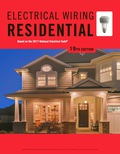
EBK ELECTRICAL WIRING RESIDENTIAL
19th Edition
ISBN: 9781337516549
Author: Simmons
Publisher: CENGAGE LEARNING - CONSIGNMENT
expand_more
expand_more
format_list_bulleted
Concept explainers
Textbook Question
Chapter 19.1, Problem 16R
What is the maximum ampere setting permitted for running overload protection of the 1-horsepower, 240-volt pump motor? ____________________
Expert Solution & Answer
Trending nowThis is a popular solution!

Students have asked these similar questions
Pls show neat and whole solution
Pls show neat and whole solution
2. Find the steady-state current i(t) in the circuit shown below when
Vs(t) = 100cos(500t -30) volts. Express your answer in cosine form i.e.,
i(t) Im cos (oot+).
(20 pts)
LLE)
10052
Vs (E)
40uF
0.3 H
Chapter 19 Solutions
EBK ELECTRICAL WIRING RESIDENTIAL
Ch. 19.1 - Does a jet pump have any electrical moving parts...Ch. 19.1 - Prob. 2RCh. 19.1 - Where is the jet of the pump located?...Ch. 19.1 - Prob. 4RCh. 19.1 - Prob. 5RCh. 19.1 - Prob. 6RCh. 19.1 - Prob. 7RCh. 19.1 - What is compressed in the water storage tank?...Ch. 19.1 - Explain the difference between a 2-wire...Ch. 19.1 - Prob. 10R
Ch. 19.1 - Why is a 240-volt motor preferable to a 120-volt...Ch. 19.1 - How many amperes does a 1-horsepower, 240-volt,...Ch. 19.1 - What size are the conductors used for this branch...Ch. 19.1 - Prob. 14RCh. 19.1 - What provides the running overload protection for...Ch. 19.1 - What is the maximum ampere setting permitted for...Ch. 19.1 - Prob. 17RCh. 19.1 - Because the controller contains the motor starting...Ch. 19.1 - Prob. 19RCh. 19.1 - Proper pressure of the submersible pump system is...Ch. 19.1 - Fill in the data for a 16-ampere electric motor,...Ch. 19.1 - The NEC is very specific in its requirement that...Ch. 19.1 - Does the NEC allow submersible pump cable to be...Ch. 19.1 - Must the disconnect switch for a submersible pump...Ch. 19.1 - A metal well casing (shall) (shall not) be bonded...Ch. 19.2 - Prob. 1RCh. 19.2 - A major hazard involved with water heaters is that...Ch. 19.2 - Prob. 3RCh. 19.2 - The heating elements in electric water heaters are...Ch. 19.2 - An 80-gallon electric water heater is energized...Ch. 19.2 - Prob. 6RCh. 19.2 - For residential water heaters, the Consumer...Ch. 19.2 - An 80-gallon electric water heater has 60F...Ch. 19.2 - Approximately how long would it take to produce...Ch. 19.2 - Two thermostats are generally used in an electric...Ch. 19.2 - a. How many heating elements are provided in the...Ch. 19.2 - When does the lower heating element operate?...Ch. 19.2 - Prob. 14RCh. 19.2 - Prob. 15RCh. 19.2 - Prob. 16RCh. 19.2 - a. If both elements of the water heater in this...Ch. 19.2 - a. How much power in watts would the two elements...Ch. 19.2 - A condominium owner complains of not getting...Ch. 19.2 - For a single, nonmotor-operated electrical...Ch. 19.2 - A 7000-watt resistance-type heating appliance is...Ch. 19.2 - Prob. 22R
Knowledge Booster
Learn more about
Need a deep-dive on the concept behind this application? Look no further. Learn more about this topic, electrical-engineering and related others by exploring similar questions and additional content below.Similar questions
- 1. Determine the thevenin equivalent circuit (i.e., Vth, Zth) from the terminals a-b in the circuit shown below. (15 pts) j512 1052 1020arrow_forwardNeed schematic diagram for this computerized don't use guidelines answer okk will dislikearrow_forwardthe question with its answer but i still dont see how the expansion and the calculation done. please show detailed steps.arrow_forward
- Q6) Find the current density J for the magnetic field intensity vectors: (a) H = x²yax + y²zay - 2xzaz pzap + p³a + 3pz²a (b) H = sin cos (c) H = a,arrow_forwardConsider the following circuit which implements functions fand g: x1 x3 x1 x3 D X4 x1 x2 x2 m الله الله X4 x2 X4 x3 x1 x4 x1 D g a) What is the cost of this circuit, assuming that the input variables are available in both true and complemented forms? b) Redesign the circuit to implement the same functions, but at as low a cost as possible. What is the cost of your circuit?arrow_forwardQ2) Line x = 0, y = 0,0arrow_forwardConsider the following logic functions: f = x₁x2x3 + x2X4 +X1X2X4 +X2X3X+X1X2X3 8 = (x2+x3 + x4)(x1+x2 + x4)(x2+x3+X4)(x1+x2+x3)(x1+x2+x4) Prove or disprove that f = garrow_forwardNo AI, Use pencil and paperarrow_forward1. For the circuit shown, let Is = 10, R₁-45, R2-5, R3-5, and R4-45, to find: (choose the closest value in volts) (V) {NOTE: On Multiple Choice Questions, like this problem, you have only one attempt } • Vab 50 (V) -25 225 R₁ a R2 RA b R3 Vabarrow_forwardpower systemsarrow_forwardFind G(s) = Vs(s) / Ve(s) for this circuit belowarrow_forwardCalculate the magnitude of the current in the coils e1, e2 of the magnetic circuit, if: ɸa = 3,00 x 10-3 Wb, φb = 0,80 x 10-3 Wb, ɸc = 2,20 x 10-3 Wb L AB = 0,10 m, L AFEB = L ACDB = 0,40 m AAB = 5,0 cm2 A AFEB = A ACDB = 20 cm2 Material characteristics H (At/m) 240 350 530 1300 5000 9000 B (T) 0,7 0,9 1,1 1,3 1,5 1,6arrow_forwardarrow_back_iosSEE MORE QUESTIONSarrow_forward_ios
Recommended textbooks for you
 EBK ELECTRICAL WIRING RESIDENTIALElectrical EngineeringISBN:9781337516549Author:SimmonsPublisher:CENGAGE LEARNING - CONSIGNMENT
EBK ELECTRICAL WIRING RESIDENTIALElectrical EngineeringISBN:9781337516549Author:SimmonsPublisher:CENGAGE LEARNING - CONSIGNMENT

EBK ELECTRICAL WIRING RESIDENTIAL
Electrical Engineering
ISBN:9781337516549
Author:Simmons
Publisher:CENGAGE LEARNING - CONSIGNMENT
Photoelectric Effect, Work Function, Threshold Frequency, Wavelength, Speed & Kinetic Energy, Electr; Author: The Organic Chemistry Tutor;https://www.youtube.com/watch?v=-LECEvusk8E;License: Standard Youtube License